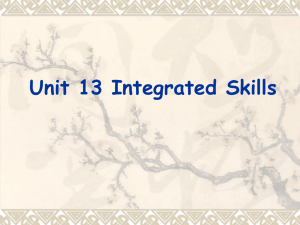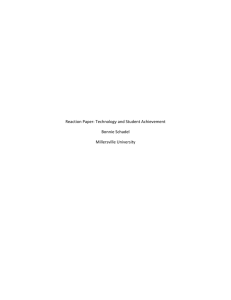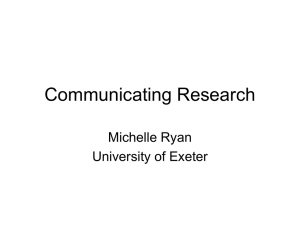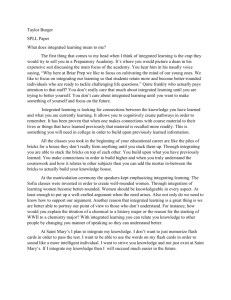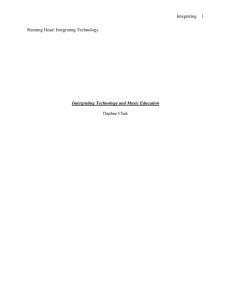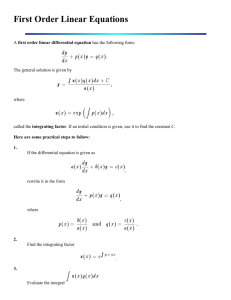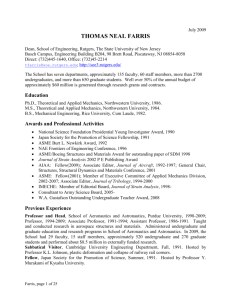Social Studies Integration Research - Jennifer Kelly
advertisement
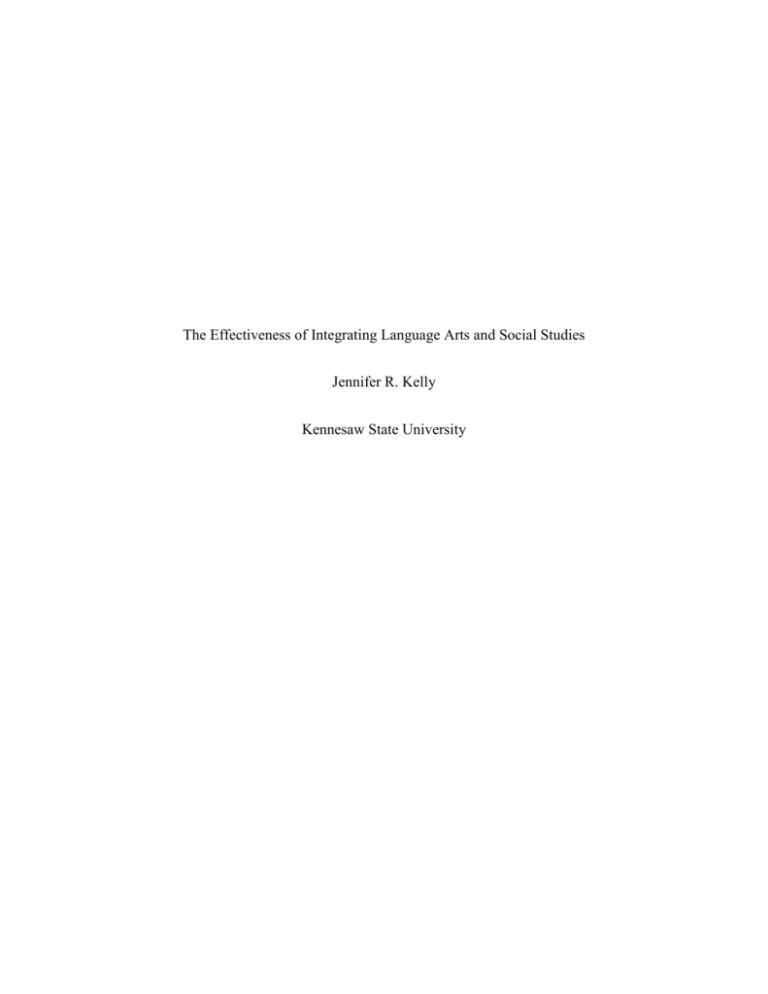
The Effectiveness of Integrating Language Arts and Social Studies Jennifer R. Kelly Kennesaw State University INTEGRATING LANGUAGE ARTS AND SOCIAL STUDIES 1 Introduction According to the National Council for Social Studies (NCSS, 1992), social studies is defined as, “…the integrated study of the social sciences and humanities to promote civic competence.” The NCSS (1992) also states, “The primary purpose of social studies is to help young people make informed and reasoned decisions for the public good as citizens of a culturally diverse, democratic society in an interdependent world.” The subject of social studies lays the foundation for our future by producing productive members of society. Social studies prepares children by giving them the knowledge they need to make sense of the world today and help make better decisions tomorrow. It seems that overtime society has forgotten the importance of teaching social studies to young children. The historic national goal of education has been to educate youth for the purpose of democratic citizenship (Hinde, 2005), yet social studies has become an overlooked content area in most classrooms today, especially among elementary classrooms. This is primarily due to the fact that the focus of education has been solely on mathematics and language arts since the No Child Left Behind (NCLB) act. In result, teachers are held more accountable for these subjects leaving other content areas such as social studies on the back burner. Ultimately, social studies is left with little to no instructional time because of the pressure teachers are under to prepare their students for other areas on standardized testing (Field, Bauml, & Ledbetter, 2011; Hinde, 2005). A study by Marzano (2003) states there is an average of 200 standards and 3,093 benchmarks across all content areas that teachers are expected to teach each year. Marzano (2003) goes on to calculate that teachers would need approximately 15,465 hours to adequately address each standard; however, most teachers only have 9,042 hours of instructional time each INTEGRATING LANGUAGE ARTS AND SOCIAL STUDIES 2 school-year. So, how can teachers implement social studies without sacrificing instructional time for other content areas? Review of Literature Integrated Curriculum The integrated curriculum approach is far from new. During the progressive movement, John Dewey and Francis Parker were the first to pose the idea of integrated curriculum (Hinde, 2005). Since then, the approach of integrated curriculum has taken form in various models and has been a widely studied topic. Subsequently, debates have been ongoing among educators on the effectiveness of integrated curriculum for several years (Hinde, 2005). Advocates of integrated curriculum point to studies that suggest integration leads to higher student achievement, while those not in favor point to studies of their own proposing that a discipline-centered approach to curriculum is the most effective method (Hinde, 2005). Nonetheless, when researching this topic, it seems the integrated curriculum approach has more positive outcomes in students’ academic success. Hinde (2005) gives an example of this through an eight year study conducted in the 1930’s where researchers found that students who attended schools that used the integrated curriculum approach were more successful than their college peers who attended traditional discipline-centered schools. Other studies state an increase in student engagement through integrated thematic units, and heightened positive attitudes toward learning when integrated curriculum is implemented (Hinde, 2005; McBee, 2000). INTEGRATING LANGUAGE ARTS AND SOCIAL STUDIES 3 Effective Integration Before teachers can effectively integrate language arts and social studies, it must be known that integration is a teaching method rather than merely listing learning objectives (Hinde, 2005). Many teachers often mistake curriculum integration for simply adding social studies vocabulary words to spelling lists or having students list these words in alphabetical order (Hinde, 2005). These types of activities hold no educational value. Another mistake teachers frequently make is trying to integrate too much content which does not leave room for in-depth learning to take place (Hinde, 2005). It is crucial for teachers to know how and when to separate and integrate topics (Parker, 2005). The effectiveness of integration boils down to teachers’ knowledge of the content area being integrated as well as integration techniques. By effectively integrating social studies in elementary classrooms, today’s youth can grow to become leaders who are prepared and hold civic sustainability. According to Hinde (2005), to provide effective integration teachers must use activities which hold significance to all content areas being taught as well as authentic skills. In addition, when integrating curriculum lessons should be developmentally appropriate for students. Integrating Social Studies and Language Arts Studies suggest that integrating social studies with other content areas can provide students with meaningful instruction (Field, Bauml, & Ledbetter, 2011; Zagora, 2011). In fact, Zagora (2011) noticed that students perceived writing to be more relevant when integrated with social studies. Field, Bauml, & Ledbetter (2011) note the effectiveness of integrating social studies, reading, and writing by preparing curriculum units strategically. It is important to first, INTEGRATING LANGUAGE ARTS AND SOCIAL STUDIES 4 determine the major concepts which need to be taught for each subject; this will help guide the search for meaningful instructional materials (Field, Bauml, & Ledbetter, 2011). Finding a variety of resources such as literature, primary sources, reader’s theater scripts, and multimedia sources will provide a higher level of effectiveness when integrating curriculum (Farris, 2015; Field, Bauml, & Ledbetter, 2011). Integrating social studies and reading. There are unlimited opportunities throughout the day to integrate social studies with reading. Farris (2015) suggests many ways teachers can integrate social studies and language arts such as reader’s theater and close reading. The author goes on to recommend using children’s literature by quoting Barbara Moss and Terrell Young (2010), “Reading is powerful. It creates compassion, moves us to action, transports us to different places, and even sometimes transforms us. Reading can change lives” (Farris, 2015, p. 61). Using children’s literature can help students develop reading skills aligned with grade-level standards as well as social studies knowledge. In fact, teaching history and historical figures through literature could be the most beneficial learning tool. Integrating social studies and writing. Both reading and writing are content areas which can easily be integrated with social studies. Farris (2015) considers these content areas to be high processing means of making sense. As mentioned before, students have shown an increase with making meaning of social studies topics in addition to their writing skills when social studies and writing are integrated (Zagora, 2011). According to Farris (2015), writing is a way for students to not only generate meaning but also ideas and questions. Writing activities may include students reflecting on primary source INTEGRATING LANGUAGE ARTS AND SOCIAL STUDIES 5 documents from historical events or people being studied, and then writing about what they would have done in that situation. The options are endless. Integrating social studies and speaking and listening. Speaking and listening are other areas of language arts that play an important role when teaching or learning about social studies. Social studies naturally involves the standards of speaking and listening when adequately taught, so many teachers probably do this without even realizing. Although speaking and listening are two different components which require separate skills they go hand-in-hand with one another (Farris, 2015). Speaking requires the ability to articulate ideas and knowledge through learned vocabulary (Farris, 2015; Zagora, 2011). When asking students to present social studies’ topics, students must be able to refine their ideas based on what they have learned, and communicate these thoughts effectively (Zagora, 2011). Listening requires students to anticipate what the speaker will say by calling on prior knowledge in order to make sense of what the speaker is saying (Farris, 2015). Engaging students in group discussion refines their speaking and listening skills while using higher level critical thinking and furthering their understanding of that topic. Conclusion While researching this topic, I realize just how powerful you can make social studies through integration. Using primary sources can be a great and easy way to integrate language arts and social studies. For example, sharing historical figures’ original letters, journal entries, and speeches will provide reading, writing, speaking, and listening opportunities as well as develop students’ understanding on how these people helped shape the world we live in today. As INTEGRATING LANGUAGE ARTS AND SOCIAL STUDIES 6 teachers, we often forget that primary documents, such as those, are learning tools that empower students to stand-up for meaningful causes. Another integration strategy I took away from this research is readers’ theater. The articles read for this research assignment support teaching social studies through children’s literacy and allowing students to reenact history (Farris, 2015). I think using reader’s theater will help illustrate the pain, hope, and courage people were feeling during specific times in history while meeting reading standards. Using emotions while reading turns words into powerful messages which can be used as a great tool for making instruction meaningful. Lastly, to help my students make connections between topics and events, I will create an on-going classroom timeline. This will integrate language arts by having students read materials and write something meaningful on the topic being taught as well as present and listen to others. Placing events in chronological order will provide better understanding and assist in making powerful connections between events and topics. Overall, this research paper closely examines the effectiveness of integrating language arts and social studies through a variety of techniques. After much research, I think integration can be beneficial to students and teachers if designed and implemented sufficiently. I plan to integrate language arts and social studies by developing units which include a variety of resources to further my students’ understanding of social studies’ topics. Through integrated curriculum, teachers can continue to address content areas for which they will be held more accountable without forgoing social studies (Hinde, 2005). INTEGRATING LANGUAGE ARTS AND SOCIAL STUDIES 7 References Farris, P. J. (2015). Elementary and middle school social studies: An interdisciplinary, multicultural approach. (7th ed.). Long Grove, IL: Waveland Press Inc. Field, S. L., Bauml, M., & Ledbetter, M. (2011). Every day successes: Powerful integration of social studies content and English-language arts. Social Studies and the Young Learner, 23(3), 22-25. Hinde, E. R. (2005). Revisiting curriculum integration: A fresh look at an old idea. The Social Studies, 96(3), 105-111. Marzano, R. J. (2003). What works in schools: Facilitators guide. Alexandria, VA: Association for Supervision and Curriculum Development. Retrieved from: http://www.ascd.org/ASCD/pdf/siteASCD/video/WhatWorksinSchools.pdf McBee, R. H. (2000). Why teachers integrate. The Education Forum, 63(3), 254-260. Parker, W. C. (2012). Social studies in elementary education. (14th ed.). Boston, MA: Pearson. Zagora, V. M. (2011). An approach to integrating writing skills into the social studies classroom. Social Education, 75(1), 17-21.
